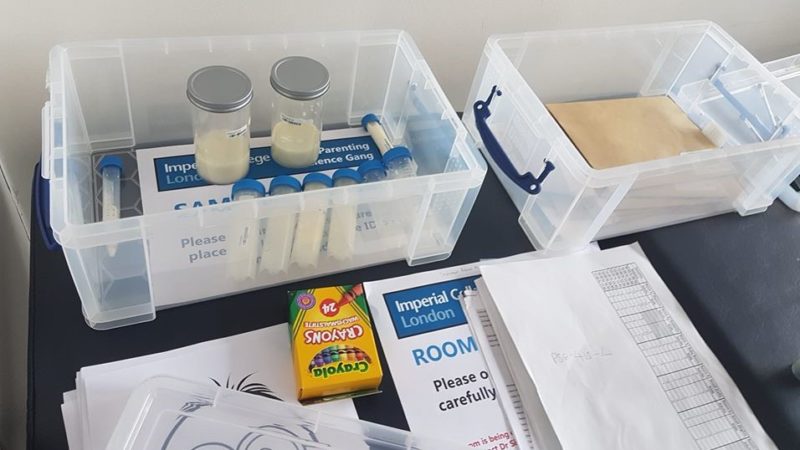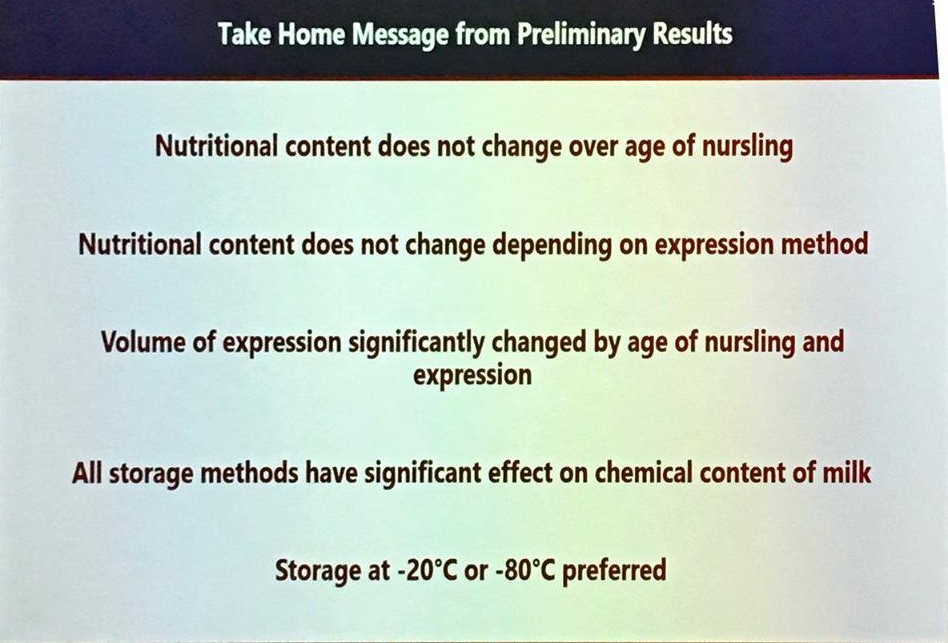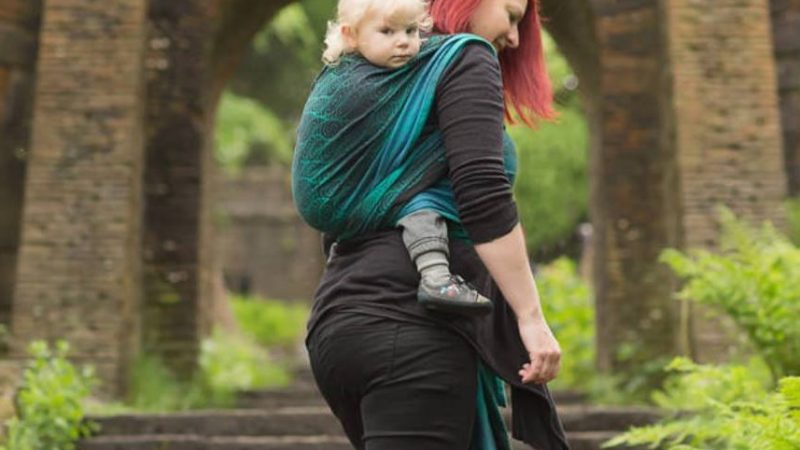
Breast milk for older children – results Q&A with Dr Simon Cameron
Our breastfeeding groups – Breastfeeding Older Babies and Beyond (BOBAB) and UK Breastfeeding and Parenting Support (UKBAPs) groups – wanted to know the answer to the question:
What is in breast milk produced for children over 2 years old?
We partnered with Dr Simon Cameron (then at Imperial College, London; now Queen’s University, Belfast) and Dr Natalie Shenker (Imperial College, London and Hearts Milk Bank).
A total of 132 breastfeeding mothers came to Charing Cross Hospital in London to express breast milk and the samples were analysed in a mass spectrometer (REIMS), and by microbiome analysis. The fat levels were observed.
Back in 2019 we had a Q&A with Dr Simon Cameron about the results of the breast milk experiment, here is a transcript of that chat:
PSG A: A quick reminder before we get started – here’s a summary from the last time we talked results.
Simon also said at the time:
“Almost single handedly you have opened up a new area of research… I am incredibly passionate [about breast milk research] now. For me it’s one of the few areas of research that affects everyone everywhere anytime.”
Welcome Simon!
We hope the move to Belfast has gone well? We’re all looking forward to the next instalment of the results.
Simon Cameron: Hi everyone. The move to Belfast has gone well thank you and settling in to the University. I’ll be doing a lot more work on human milk here which is very exciting.
Natalie and myself are working on the publication at the moment and we hope to have a draft ready in the next few months.
Science can move at a glacial pace at times but this is down to how much analysis we can do on our data set.
PSG D: Do you mean that because you have so much data, there are lots of different ways to look at it / process it?
Simon: Yep, you’re right
Who are we submitting to?
Simon: We think we will have two papers – one on the composition of the milk over the lactation period and another on the effect of different storage conditions
PSG E: Sounds great
Simon: For the composition we are looking at a journal that would be ready by healthcare professionals and for the storage one more for a food chemistry audience
PSG E: I take it this would be a good reference for milk banking.
PSG F: I’m curious about the food chemistry audience. Of course it *is* food, but how do you think this audience will use the info? Do they work in milk banks etc?
What stage are you at?
Simon: We are still working on the effect that diet and other lifestyle factors has on the expressed milk but we have finished the analysis looking at the bacteria the milk samples contain
PSG H: This is a tricky one as it could potentially deter people from breastfeeding or be used as propaganda by formula companies as diet has been used this way in the past.
PSG I: Still it would be really good to know what impact, if any, supplements have. This is such a regularly discussed topic on BOBAB.
PSG H: I’m not sure we measured for supplements?
Simon: We asked for supplementation including Vitamin D, folic acid, calcium, and then information on diet including meat and fish intake and fruit and veg.
PSG J: This links to the presentation at the LCGB conference about how maternal diet can change the types of fat in breast milk.
PSG J: We were discussing in another group the extent to which WEIRD (Western, Educated, Industrialised, Rich, Democratic) diets have taken us away from biologically normal baseline diets and how this *may* have an effect on breast milk. The framing of this is very tricky as you highlight.
PSG F: We do need to remember that the results will be what they are, and we have little control over how the media will portray them. This would not be an issue with the study, and may have really important Public Health messages (or not)
What are the findings so far regarding diet?
Simon: This is the last bit of analysis we are working on now. It’s quite a lot of data to work through but we’re getting there!
What are some of the things you’ve found since results day that has you really excited?
Simon: The main new result is that the bacteria that is present within the milk samples doesn’t seem to be affected by the length of lactation and it is pretty much the same bacteria we see over the range we were looking at
This is good as it suggests that there isn’t suddenly an increase in pathogens (bacteria that could potentially cause disease) which would be an issue for things like donor milk
PSG H: As in the age of their child?
PSG G: Simon: do we assume this is to maintain gut microbiome? Or do we not know yet?
Simon: It’s very difficult to make assumptions from this experiment as we have just looked at a single time point for people rather than following them over a period of time and we don’t know what bacteria are present in the children’s guts as we didn’t sample them.
PSG A: I remember you talking about very preliminary results that suggested perhaps the levels of bacteria were lower than people might expect, and that that might have implications for the treatment of donor milk – i.e. no need to pasteurise. (Which is done on human donor milk for historical & cultural reasons not evidence based at the moment as I understand it?)
PSG D: Are you able to say what type of bacteria it is?
PSG M: The same bacteria is present in all samples regardless of age of nursling/age of mother?
Simon: These are the main sort of bacteria that other studies have found in human milk and appear to be the ones that form the early microbiome including Bifidobacteria. I’m not in front of my work computer so can’t recall all of the different types but could send a summary round after this session.
PSG C: It would be a very welcome result if the evidence means donating milk rules are relaxed. Most mums can only think about donating when their baby is older, but by then it’s too late under current rules.
Simon: It would be difficult to make that suggestion from this study alone but it certainly suggests that it is an area to explore more
PSG G: Yes that’s true! If that were to be looked at how does that work? Sampling poo??? ?
Simon: Yep, that’s what we would have to do! We’ve done a lot of work on it in the group and it’s not as bad as it sounds.
PSG G: It does sound bad to be honest but interesting none the less ?
PSG B: Simon: I work in research in the NHS in Swansea and one of our professors has done a study on baby poo and breastfeeding and bottle feeding and antibiotics! All very interesting this gut biome business ?
Simon: I would be interested to read that study
PSG B: Please feel free to drop me a message and I can put you in touch with the prof and send you the results! I think he’s added another arm to the study now! I told him about this breastmilk study last year and he too is very interested to hear your results:-)
PSG O: Are they also looking at the different ways a baby might be BF so exclusive feeding direct from the breast vs exclusively feeding expressed milk vs combination of expressed/direct and then I guess biomes of those fed donor milk?
PSG O: I don’t think so but I can certainly ask for you ?
Has your team had a chance to do any work on looking at the composition of the milk, compared to the frequency at which the mother was feeding her child(ren)
Simon: We were planning on doing that. but I can’t find a reference to that on the questionnaire or form for the day – if you could point me to where we asked for it that would be really useful
PSG A: It was question 10.5.
Simon: Great, thank you. I’ll look into it.
Are there any new results regarding the milk from tandem feeders?
I’ve heard that the milk supply will adjust to the youngest child’s needs (so newborn milk after birth etc.). Did your results confirm that? And did they find out anything further?
Simon: Great question. The tandem feeders were a tricky one as it looked like most people didn’t have a preferred side for each child so a direct comparison between the two was tricky. On the whole, the milk from tandem feeders didn’t appear different in terms of volume or fat content or what we detected with the mass spec than any of the other groups
Again, this is quite a tricky one to definitely answer with this study as we just sampled at one time point. It would be really interesting to collect samples over the whole period of tandem feeding as this would help to answer your question
PSG A: Where women gave two samples. one from each side. have you compared them to see if there’s any detectable difference in composition for that individual? (I understand several participants who weren’t tandem BFing also gave both sides).
If anyone has any difference at all, then we’d know in principle that milk can be different by breast, even if we didn’t know why.
Where are you next excited to investigate as you’ve continued with your analysis?
Simon: What I’ll be working on for the next year or so is developing tools that we can use to get a really deep understanding of what human milk contains across areas like fats and lipids, proteins, and microbes but also what the milk is capable of doing in terms of its antimicrobial activity
Having these tools will allow us to answer a lot more questions in the future but I’m very excited about looking at how we can measure the antimicrobial activity of different milk samples
PSG L: Would that involve using a different machine altogether?
Simon: Lots of different ones potentially. As human milk contains so many different components there really isn’t just one technique we can use to study them all
I wanted to ask if any of the participants were pregnant and breastfeeding?
If so, did this change the composition of the milk?
PSG A: No one was (knowingly) pregnant in this study, we excluded from pregnancy
PSG R: One of the criteria for participants was not to be pregnant.
It would really be an interesting study though! As mums often face criticism if they feed during pregnancy.
Where women gave two samples. one from each side. have you compared them to see if there’s any detectable difference in composition for that individual, between both sides?
(I understand several participants who weren’t tandem BFing also gave both sides).
If anyone has any difference at all, then we’d know in principle that milk can be different by breast, even if we didn’t know why.
Simon: There would be differences I imagine but the issue is that as we have just one sample from each at one point in time it’s impossible to say whether they are ‘real’ differences
PSG A: Yes, I understand it’d be a snapshot and impossible to draw solid conclusions from, but it would still be of enormous interest to all the women involved in this because of interest in tandem BFing. Even if it came with massive caveats, it’d be hugely interesting to us to see if milk from each side can have any detectable differences, even if only as a moment in time.
Would it be possible to get the data on this out of the study data?
PSG I: If composition doesn’t vary with age of child then why would it vary for tandem feeding?
PSG A: I don’t think this research has conclusively proved no difference in breast milk over time.
My memory is… It’s proved that – for the constituents that REIMS can pick up – there was no difference in overall types of constituent. There may be a difference in the levels of those constituents over time, however.
Or, to be more exact, there was no difference in the constituents present in the milk. The levels of those constituents may vary over time, however, but last time we spoke that was tbc…
(And quite difficult to do, perhaps?)
PSG I: Ah, I was just going by the take home results.
PSG G: I donated the milk from one side to the breast cancer research lady ?♀️
PSG K: do you mean you only pumped one side, or that you had one side for your child & one side for donation?
PSG G: My daughter was 3 when I took part in the experiment and it took me 40 mins to express 10ml from one side and about 12mls from the other side, then a lady wanting breast milk for breast cancer research came to see if anyone would be happy to donate milk to her so I donated one tube to her and the other to this experiment ?
My daughter feeds from both sides ?
I’ve heard that a woman’s breast milk becomes more concentrated as babies get older and feed less and almost returns to being colostrum like as weaning approaches.
Is this something you have/could test?
Simon: The volume of milk expressed when the child feeding is older decreases but we didn’t see a change in fat percentage or what we detected with the mass spec.
What’s the best way to keep up to date with your work?
Both the papers you’re working on now and your future work on breast milk? Is there maybe a mailing list or blog or something?
Simon: We have the email addresses of everyone who took part in the study so we can update that way with the final results and papers. I think we can also use the Facebook groups too for updates?
PSG AD: Super. The Facebook group would be good. I wasn’t at the actual study, and I would think many others who weren’t there on the day would like to follow your work too.
Did you see the recent Polish study on breastfeeding older children?
Simon: I read the study and although it’s interesting I’m not 100% sure I agree with their conclusions based on their data analysis
PSG AB: So you think the difference is due to analysis methods? Is there a plain English way you could explain it for me?
Simon: I would argue that the conclusions they have drawn aren’t fully supported by the data that they present in the study.
PSG F: It would be helpful to those of us who do not work in research etc if you could expand on this a little please
PSG AC: Would love a discussion about this – is there anyone else who’s done an analysis of the paper?
PSG AB: Do we have any of the right kinds of scientists to read the Polish paper? It might getting down to disagreements between types of scientists. It’s beyond my ken.
What would say to another pro scientist wondering whether to get involved in a citizen-led project?
Simon: I would definitely encourage them
Is your new uni looking for participants in any studies?
Simon: That’s the plan for the future but it will take a bit of time to set up the infrastructure that we need at Queen’s.



